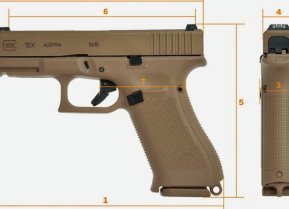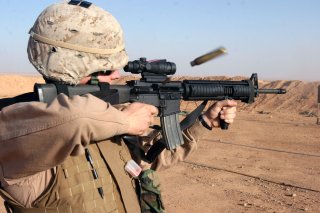IMP and SCAMP: Colt Made These 2 Guns Truly One of a Kind
The IMP and SCAMP were fascinating designs that sadly went nowhere.
In the modern firearms world, Colt isn’t on the cutting edge of firearm technology. However, in 1969 the case was different. In that year, Colt designed two guns you don’t hear of these days, the SCAMP and the IMP.
These unique names were more or less applied to a series of prototype firearms that never made it to mass production. Those are seemingly odd names for a weapon, but when we break the two down, the names start to make sense.
THE IMP
It was 1969 and the world was just beginning to experience hallucinogenics, and it shows with the design of the IMP. I joke and jest, but this is a very odd weapon. The weapon’s name is actually an acronym that stands for Individual Multi-Purpose Weapon, and you won’t convince me the name was a funny coincidence. The original purpose of the IMP was to provide pilots in the U.S. Air Force with a sidearm with more range and penetration than an SMG but in a smaller platform than a rifle.
The original prototype was designed at the USAF Armament Laboratory in Elgin, Florida. Colt would go on to further develop the platform and create a more refined and functioning firearm. The weapon was a bullpup, which means the magazine and action are behind the trigger. This reduces the size of the firearm without reducing the barrel length. IMP lacked a stock and instead was designed to rest on the arm and be fired like a pistol and its magazine held 30 rounds
The rear of the weapon would rotate left or right to provide a stable platform for the shooter. The IMP was designed to be a very compact weapon that fired a round known as the .221 Fireball.
The IMP wasn’t quite a submachine gun, and it wasn’t quite a rifle either. It fell in a niche category of firearms known as Personal Defense Weapons (PDWs) which fall in between rifles and submachine guns. It offered shooters a fire rate of 550 rounds per minute. The weapon was only 17.1 inches long, with a barrel that was 10 inches long. Colt produced five prototypes, but the weapon never left the prototype stages.
THE SCAMP
In 1971 the Colt M1911 was already a 60-year-old design, and Colt was hell-bent on producing its replacement. The SCAMP tried to fill that role.
Colt’s SCAMP was first envisioned in 1969, but the company didn’t produce a working prototype until 1971. SCAMP is another fun acronym that stands for Small Caliber Machine Pistol.
The SCAMP was a radical firearm that offered the user selective fire capability. The SCAMP’s three-round burst could create excessive recoil, so a built-in compensator allowed the weapon to be more controllable.
The weapon chambered a cartridge known as the .22 SCAMP. This round was more akin to a rifle or PDW round with a bottleneck design and a spitzer-style projectile. When fired from the SCAMP, it would reach velocities of 2,100 feet per second. These rounds were fairly small, and the gun held 27 rounds in its magazine, which was 20 more than the M1911.
The big pistol weighed more than two pounds and was nearly a foot long, but given the size of military holster that wasn’t a big deal.
The SCAMP used a gas-operated design which was odd for a pistol. However, the weapon was reportedly very controllable, and in testing, it proved to be accurate and easy to shoot. The military was impressed, but it did not pursue the concept any further. They wouldn’t replace the M1911A1 until 1985, and it sadly wasn’t with the SCAMP. Only one SCAMP was ever built.
ODD COLT WEAPONS FOR ODD TIMES
The IMP and SCAMP were fascinating designs that sadly went nowhere. They were both fairly interesting, albeit somewhat odd, and likely not very useful overall.
While both were well-made weapons that fit specific niches, they weren’t the best option out there. This is because pistols are rarely used in warfare, and a machine pistol would be quite the leap; instead, a stock would have made the two weapons much more effective. Both were fascinating and while I’m glad they exist, I can see why their designs went nowhere.
About the Author
Travis Pike is a former Marine Machine gunner who served with 2nd Bn 2nd Marines for 5 years. He deployed in 2009 to Afghanistan and again in 2011 with the 22nd MEU(SOC) during a record-setting 11 months at sea. He’s trained with the Romanian Army, the Spanish Marines, the Emirate Marines, and the Afghan National Army. He serves as an NRA-certified pistol instructor and teaches concealed carry classes.
This article was first published by Sandboxx News.
Image is M16 firing from U.S. Marines Flickr.


